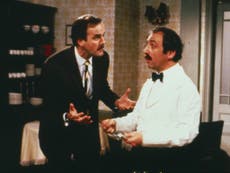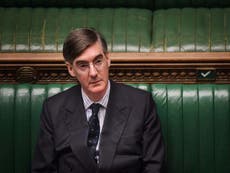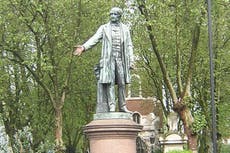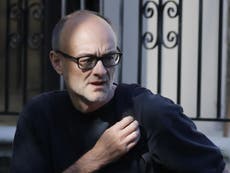This weekend's Black Lives Matter rallies are a chance to overhaul the role of police in British protest
The police’s role is to facilitate protest, not prevent it. Sound judgement and thoughtful decision-making in the moment are what is needed in public order situations
Widespread anger over the murder of George Floyd in Minneapolis three weeks ago have presented the police with a predicament: how to manage demonstrations when you become the target? Though last weekend’s Black Lives Matter and Edward Colston protests produced dramatic scenes, they also showed some forward thinking ways in which the police can engage with justified public outrage.
Sir Robert Peel, who founded the Metropolitan Police in 1829, and is widely considered the father of modern day policing, declared that policing by consent is “dependent upon public approval of police existence, actions, behaviour and the ability of the police to secure and maintain public respect.”
Some media reports have framed protests in London and Bristol as some kind of breakdown in law and order, even rioting, aided by dramatic photos of injured police officers and defaced statues. However, when you scratch the surface, a more nuanced picture emerges. Watching the footage from London, two patterns can be observed. The first is that, on several occasions, officers backed away from an advancing crowd, to create space to reform their cordon line, giving protesters the choice to escalate or not.
And second, protesters used this interval to quell the small element of unruly members in their midst. These practices showed the police using crowd psychology rather than brute force, allowing demonstrators to try to maintain the peaceful nature of the protest.
One of the key moments during the London protests was the Met’s mounted police charging at protestors in Whitehall. The resulting melee caused chaos and panic, with one officer being seriously injured. During my policing career, I was saved by a colleague on horseback when I was pinned against a wall by a hostile crowd but, on balance, the deployment of horses clearly inflames protest and risks greater harm than the benefits they might bring.
You don’t need horses to provide an elevated view anymore, drones can do that. Horses bring an increased risk of injury to protestors, police, and to the horses themselves. Coupled with the huge expense of maintaining them, a review of the role of horses in policing is overdue.
In Bristol, we saw both the inevitable conclusion of historical injustice, and history itself. Every day that the slave trader Edward Colston’s statue stood was an insult to black people and our ancestors. The police’s role is to facilitate protest, not prevent it. A statue pulled down and thrown into the water can be retrieved and repaired, potential offences investigated.
Nobody got hurt and indeed the view of Bristol’s chief constable, Andy Marsh, was that intervention would have risked harm to protesters and police alike. Sound judgement and thoughtful decision-making in the moment are what is needed in public order situations. Here, lasting damage could have been caused to the consent of the community had riot police waded in to defend the statue of a man responsible for the deaths of thousands of kidnapped Africans.
We all have a duty to help prevent the spread of Covid-19 and protest shouldn’t be an excuse to abandon vigilance but, to echo the words of Raheem Sterling, racism is a disease too. Sometimes when we fight for what we believe, rules get broken. Only a few weeks ago Cressida Dick’s officers and members of the public stood close together on Westminster Bridge for the weekly 8pm “Clap For Our Carers”, breaking social distancing rules.
If we talk about leading by example, it is also increasingly difficult to give instructions to the public on mass gatherings when behaviour by people in power seems to make a mockery of the rules. Last week’s absurd sight of MPs bunched together in snaking queues around parliament only added to a widespread perception of governmental double standards and yet more distrust of authority that the Cummings saga helped to cement.
The response by the prime minister and the home secretary to this weekend’s protests has failed to take this into account or adequately acknowledge the outrage over structural racism and the whitewashing of history. It is reminiscent of David Cameron’s summary of the 2011 English riots as “criminality, pure and simple.”
Policing protest in the UK still has some progress to make – reports of kettling demonstrators and legal observers is disappointing – though it’s a far cry from the brutal suppression in the United States, or the liberal use of tear gas in France, or the mass arrests in Belgium seen over the weekend.
Public order policing is a huge challenge. Commanders on the ground have sometimes seconds to make decisions. This weekend shows the value of taking a reasonable, co-operative approach and reading the crowd.
Considering the palpable tension throughout the country, it is a wonder that the disorder was not of a higher magnitude. An evidence based, independent review of the role of the police in protests may allow today’s anger to be channelled in a productive way.
Nick Glynn is a retired senior police officer, and an expert on police use of force, racial profiling and stop and search. He is a senior program officer at Open Society Foundations where he leads the Better Policing portfolio.






Join our commenting forum
Join thought-provoking conversations, follow other Independent readers and see their replies